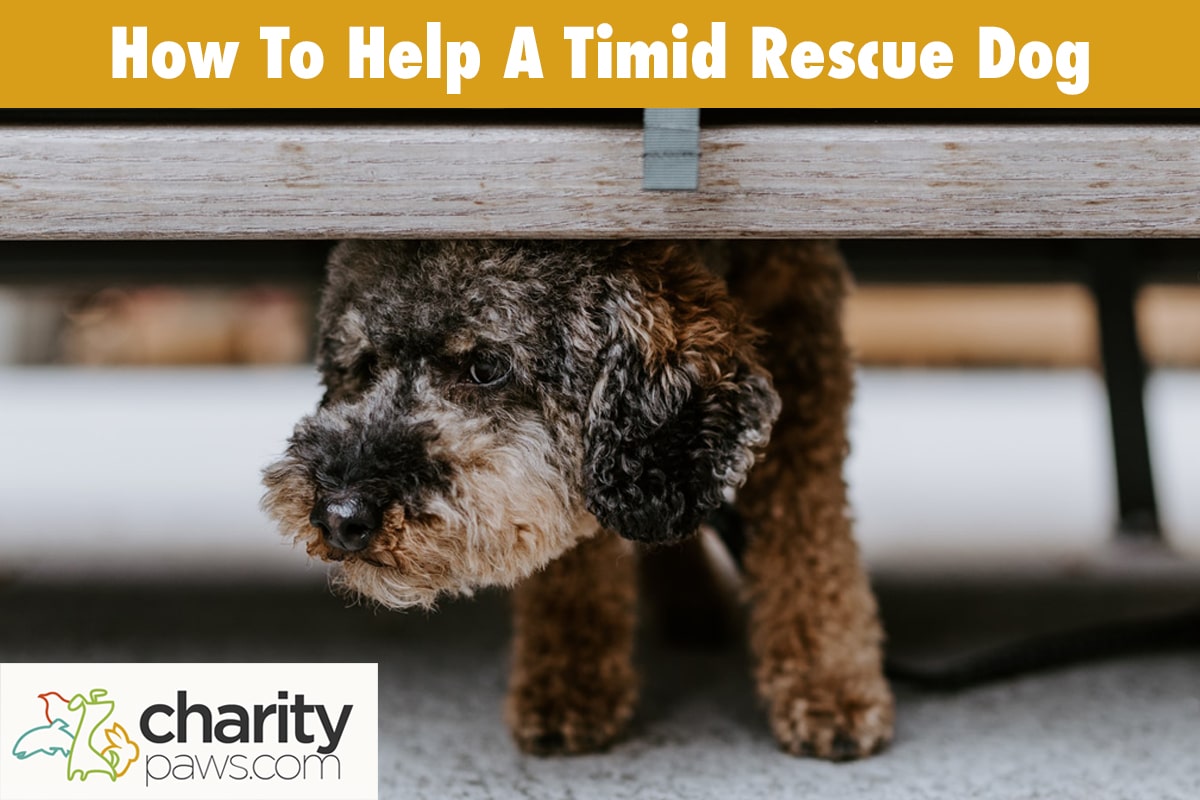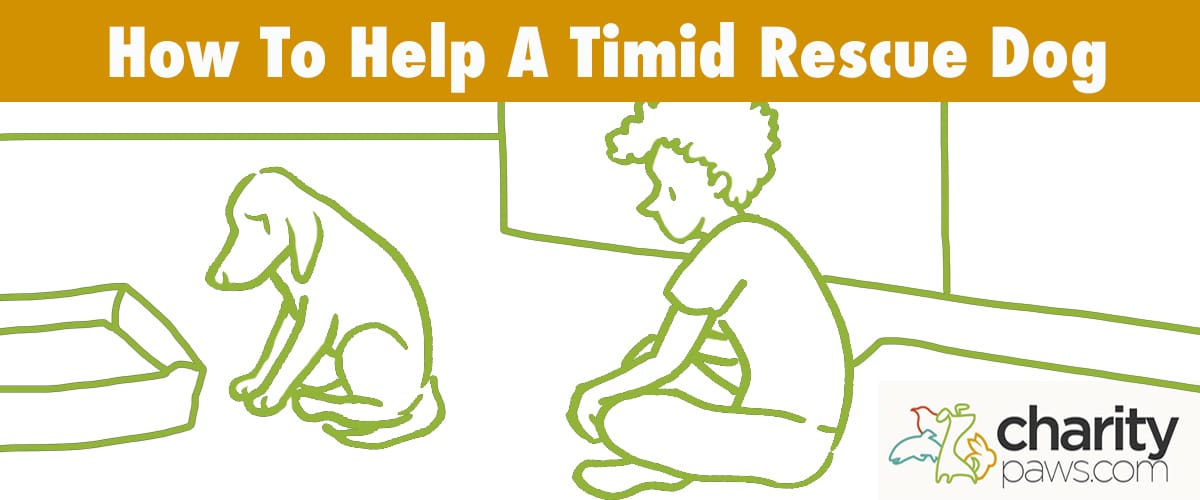Welcoming a rescue dog into your home can be a wonderful time.
Though you know you will have plenty of beautiful years ahead with your new canine friend, the adjustment period can be challenging.
The adjustment period can be tough for any canine friend, but especially a timid rescue dog.
These dogs will often require extra love and care to help them grow comfortable in their new home, and to allow their incredible personality to shine through.
To help you best accommodate your shy rescue dog, let’s discuss the most effective ways to help them feel comfortable in their new home.

Understanding Timid Rescue Dogs
Before we get into the details of helping your timid rescue dog, it’s important to try to understand where they are coming from.
Many rescued and adopted dogs are unsure of their surroundings due to the many changes they have been forced to endure, causing them to appear shy or nervous.
Just imagine waking up each day and not knowing what’s in store.
It would certainly get under your skin and lead to some behavioral shifts.
When a rescue dog is afraid of everything, it is often just a result of an unstable past.
They may be used to being plucked from stability each time they find it, so you can understand why it may take some time for them to come out of their shell and display their true personality.
Should I Adopt A Shy Dog?
If you are trying to decide if a shy rescue dog is the right dog for you, there are a couple things to consider.
First, you should be aware of the fact that just because a dog is timid at the rescue or shelter, doesn’t mean the dog will continue to be afraid as time passes within your home.
Many dogs are stressed as a result of their environment and may appear reserved until they are moved to a more comfortable space.
Many dogs will also be nervous until they have grown comfortable in their new home and will simply require patience until they come out of their shell.
So if the dog’s timid temperament is what is keeping you from adopting them, just know that their personality may change completely.
The next factor to consider is whether or not you have the right environment to offer a nervous rescue dog.
Even though a timid dog could come out of their shell once they feel comfortable, they will still need to be in a home that allows them to adjust slowly.
For example, a scared shelter dog will likely be more comfortable in a home without other dogs or young children, as this means nobody can invade their space before they are ready.
This does not mean the latter is impossible, but everyone involved will need to be diligent about giving the new pup their space as they adjust.
Once you know that you have the right environment to allow a timid rescue dog to thrive, you can move onto the steps of helping them adjust.
How Long Does It Take A Rescue Dog To Adjust?
If it seems like your rescue dog is afraid of everything, just know that this is to be expected in some pups.
It will take time for a timid shelter dog to let their guard down and come out of their shell, but they may be fearful until that time comes.
According to experts that work in the rescue field, you should always be aware of the 3-3-3 rule when adopting dogs.
This rule states that it takes 3 days for a dog to stop being afraid of their new home, 3 weeks to start to become comfortable in their new environment, and 3 months for their full personality to shine.
As you can see, it will take time for your scared dog to open up and begin to trust in their new family.
We never know what a dog has been through before they made it into our home, so we must offer them as much patience and understanding as they need.
If you do this, you will certainly be rewarded with unconditional puppy love!
How To Help A Timid Rescue Dog
If you adopt a shy rescue dog, there are a few ways to help them feel more comfortable as they adjust to their new home.
These pups will require a bit of extra patience and love, but when following these steps, you will be rewarded with a loving canine companion in the end.
Do Not Force Any Interactions
If you have adopted a skittish dog, it’s important to not force any interaction your dog is not yet comfortable with.
This includes anything from petting your new dog to picking them up, as this can further scare an already nervous pup.
We know how excited you are to cuddle your new furry friend, but it’s important to take these things slowly.
Give Them Plenty Of Space
A nervous rescue dog will need plenty of space while they explore their new home.
This will allow them to move through their new environment without fear, and without the stress of having to interact with too many new faces.
While you can certainly communicate with your pup and make sure they know you are there for them, offering ample space is the best thing while they are adjusting.
This also includes not forcing any interactions until they are ready.
Keep Your Voice Low & Soothing
Moving to a new home is scary enough, let alone the variety of new sounds they may be exposed to.
Some dogs may also have trauma surrounding loud noises and voices, so you will want to be sure to keep your voice low and soothing.
Any loud talking or activities can scare a timid rescue dog even more and may even delay their willingness to explore their new home.
Limit Any Scary Experiences
Limiting any potentially scary experiences is crucial when bringing a nervous shelter dog into your home.
For example, we know how excited you are to introduce them to your friends and family, but this should always wait until they have gotten used to their new home.
Being surrounded by too many unfamiliar faces can be terrifying for a nervous dog, so having a group of people over is not a good idea.
Your pup can likely participate in new activities once they have calmed down, but it’s best to limit these experiences when you first bring them home.
Set Treats & Toys On The Ground
Many timid rescue dogs are too scared to eat treats out of our hands, as well as grab toys from our hands.
This can be due to simply being too afraid to enter our bubble, but it could also be related to hand trauma in their past.
Setting treats and toys on the ground allows your new rescue dog to understand that even if they are too afraid to approach us, they will still get the yummy treats we have to offer.
Once these pups realize we mean no harm, they will warm up to the idea of grabbing treats and toys from us directly.
Be Mindful Of Any Obvious Fears & Address Them Later
If you notice that your skittish rescue dog has fears surrounding certain interactions or objects, it’s important to take note of these things.
While you do not need to step in and work on these fears immediately, it’s important to keep track of the things you can work on once your pup starts to feel comfortable.
Once your new dog is no longer afraid of their new home and family, you can begin to conquer these other obstacles together.
Will Your Timid Rescue Dog Get Better?

If it seems like your scared rescue pup is struggling to let their guard down, you may be wondering if they will ever get better.
Though it may be breaking your heart to see how scared your dog is at this moment, just know that it will get better with patience and love.
As we mentioned above, it can take 3 weeks for a dog to feel comfortable in their new home, and up to 3 months for you to see their true personality.
We know this adjustment is tough, but it will be worth it in the end.
Final Thoughts On Timid Rescue Dogs
Rescue dogs will often require a bit more patience and understanding as we welcome them into our homes.
It may take time for your timid furry friend to come out of their shell, but their beautiful personality will be worth the wait when it finally shines through.

